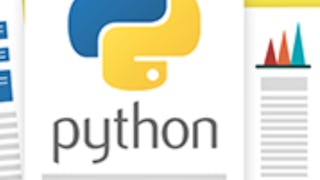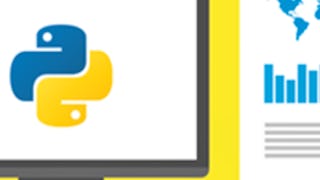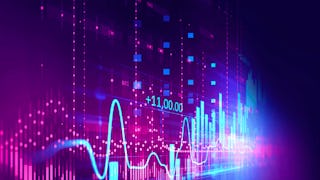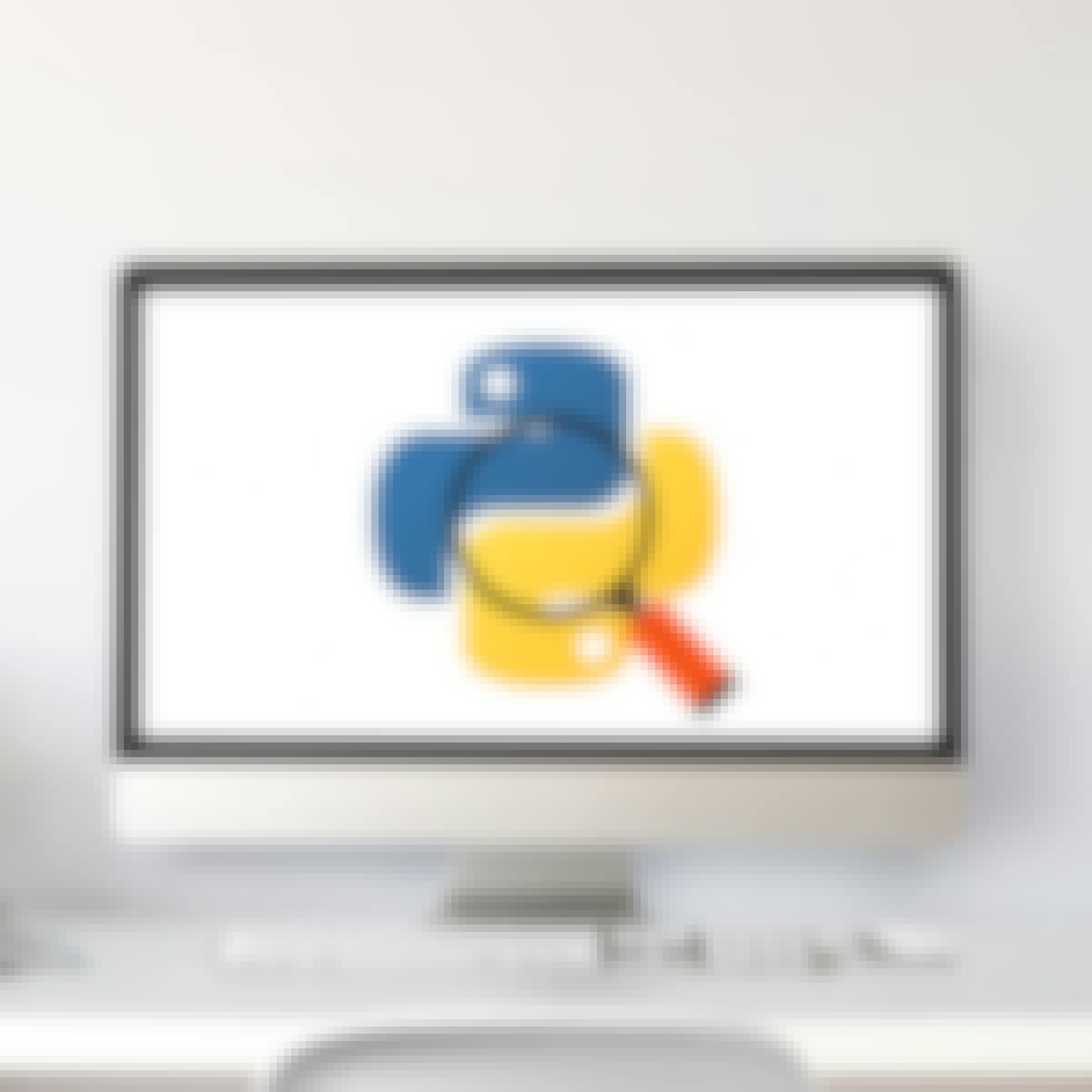- Browse
- Data Analysis With Python
Data Analysis & Python Courses Online
Explore data analysis techniques using Python. Learn to clean, analyze, and visualize data with libraries like Pandas and Matplotlib.
Explore the Data Analysis & Python Course Catalog
 Status: NewNewStatus: Free TrialFree Trial
Status: NewNewStatus: Free TrialFree TrialSkills you'll gain: Pandas (Python Package), NumPy, Data Manipulation, Data Wrangling, Package and Software Management, Data Analysis, Data Transformation, Unstructured Data, JSON, Object Oriented Programming (OOP), Data Science, Python Programming, Computer Programming, Programming Principles, Data Import/Export, Software Design, Data Validation, Mathematical Software, Computational Logic, Data Structures
4.9·Rating, 4.9 out of 5 stars50 reviewsBeginner · Specialization · 3 - 6 Months
 Status: Free TrialFree Trial
Status: Free TrialFree TrialSkills you'll gain: Exploratory Data Analysis, Data Wrangling, Data Transformation, Data Analysis, Data Cleansing, Data Manipulation, Data Import/Export, Predictive Modeling, Regression Analysis, Statistical Analysis, Pandas (Python Package), Scikit Learn (Machine Learning Library), Data-Driven Decision-Making, Matplotlib, Feature Engineering, Data Visualization, Data Pipelines, NumPy, Python Programming
4.7·Rating, 4.7 out of 5 stars19K reviewsIntermediate · Course · 1 - 3 Months
 Status: Free TrialFree Trial
Status: Free TrialFree TrialSkills you'll gain: Data Import/Export, Programming Principles, Web Scraping, Python Programming, Jupyter, Data Structures, Data Processing, Pandas (Python Package), Data Manipulation, JSON, Computer Programming, Restful API, NumPy, Object Oriented Programming (OOP), Scripting, Application Programming Interface (API), Automation, Data Analysis
4.6·Rating, 4.6 out of 5 stars43K reviewsBeginner · Course · 1 - 3 Months
 Status: Free TrialFree TrialStatus: AI skillsAI skillsI
Status: Free TrialFree TrialStatus: AI skillsAI skillsIIBM
Skills you'll gain: Exploratory Data Analysis, Data Storytelling, Data Wrangling, Dashboard, Data Visualization Software, Plotly, Data Visualization, Data Presentation, Interactive Data Visualization, Generative AI, SQL, Data Transformation, Data Analysis, Big Data, IBM Cognos Analytics, Excel Formulas, Professional Networking, Data Import/Export, Microsoft Excel, Python Programming
Build toward a degree
4.6·Rating, 4.6 out of 5 stars97K reviewsBeginner · Professional Certificate · 3 - 6 Months
 Status: Free TrialFree Trial
Status: Free TrialFree TrialSkills you'll gain: Data Visualization Software, Plotly, Data Visualization, Dashboard, Interactive Data Visualization, Matplotlib, Seaborn, Data Presentation, Data Analysis, Geospatial Information and Technology, Pandas (Python Package), Scatter Plots, Histogram, Heat Maps, Box Plots, Python Programming
4.5·Rating, 4.5 out of 5 stars12K reviewsIntermediate · Course · 1 - 3 Months
 Status: Free TrialFree TrialU
Status: Free TrialFree TrialUUniversity of Pennsylvania
Skills you'll gain: Matplotlib, Data Analysis, Pandas (Python Package), Data Visualization, Data Science, Data Cleansing, Pivot Tables And Charts, Data Visualization Software, Data Manipulation, Scatter Plots, NumPy, Data Transformation, Jupyter, Data Validation, Data Import/Export, Histogram, Python Programming, Data Structures, Programming Principles, Scripting Languages
4.5·Rating, 4.5 out of 5 stars426 reviewsBeginner · Course · 1 - 4 Weeks
What brings you to Coursera today?
 Status: NewNewStatus: Free TrialFree Trial
Status: NewNewStatus: Free TrialFree TrialSkills you'll gain: Pandas (Python Package), Pivot Tables And Charts, Data Manipulation, Data Import/Export, NumPy, Time Series Analysis and Forecasting, Business Reporting, Jupyter, Data Wrangling, Microsoft Excel, Data Transformation, Matplotlib, Data Analysis, Data Cleansing, Analytics, Data Processing, Management Reporting, Business Analytics, Python Programming, Numerical Analysis
Beginner · Specialization · 1 - 3 Months
 Status: Free TrialFree TrialU
Status: Free TrialFree TrialUUniversity of Colorado Boulder
Skills you'll gain: Unsupervised Learning, Regression Analysis, Dimensionality Reduction, Data Analysis, Anomaly Detection, Supervised Learning, Machine Learning, Analytics, Predictive Modeling, Statistical Analysis, Applied Machine Learning, Statistical Modeling, Scikit Learn (Machine Learning Library), Classification And Regression Tree (CART), Data Mining, Machine Learning Algorithms, Exploratory Data Analysis, Machine Learning Methods, Feature Engineering, Data Science
4.7·Rating, 4.7 out of 5 stars28 reviewsIntermediate · Specialization · 3 - 6 Months
 Status: Free TrialFree Trial
Status: Free TrialFree TrialSkills you'll gain: Dashboard, Pandas (Python Package), Web Scraping, Jupyter, Matplotlib, Data Analysis, Data Science, Data Processing, Data Manipulation, Python Programming, Data Collection
4.5·Rating, 4.5 out of 5 stars4.8K reviewsIntermediate · Course · 1 - 4 Weeks
 Status: Free TrialFree TrialU
Status: Free TrialFree TrialUUniversity of Michigan
Skills you'll gain: Statistical Hypothesis Testing, Sampling (Statistics), Statistical Modeling, Statistical Methods, Statistical Inference, Bayesian Statistics, Data Visualization, Statistics, Matplotlib, Statistical Visualization, Statistical Software, Probability & Statistics, Statistical Analysis, Jupyter, Statistical Programming, Regression Analysis, Data Visualization Software, Predictive Modeling, Data Analysis, Python Programming
4.6·Rating, 4.6 out of 5 stars3.3K reviewsBeginner · Specialization · 1 - 3 Months
 Status: Free TrialFree Trial
Status: Free TrialFree TrialSkills you'll gain: Pandas (Python Package), Data Import/Export, Matplotlib, Pivot Tables And Charts, Jupyter, Data Visualization Software, Microsoft Excel, Data Analysis, Text Mining, Data Manipulation, Data Cleansing, NumPy, Data Analysis Software, Data Integration, Data Wrangling, Time Series Analysis and Forecasting, Data Transformation, Python Programming, Data Structures, Development Environment
4.7·Rating, 4.7 out of 5 stars40 reviewsIntermediate · Specialization · 3 - 6 Months
 Status: Free TrialFree Trial
Status: Free TrialFree TrialSkills you'll gain: Generative AI, Matplotlib, Plotly, Data Ethics, Data Visualization, Data Cleansing, Data Manipulation, Exploratory Data Analysis, Pandas (Python Package), Data Transformation, Interactive Data Visualization, Data Visualization Software, Data Storytelling, Data Analysis, Scikit Learn (Machine Learning Library), Jupyter, Python Programming, Machine Learning
4.4·Rating, 4.4 out of 5 stars89 reviewsBeginner · Course · 1 - 3 Months
Data Analysis With Python learners also search
In summary, here are 10 of our most popular data analysis with python courses
- Google Data Analysis with Python: Google
- Data Analysis with Python: IBM
- Python for Data Science, AI & Development: IBM
- IBM Data Analyst: IBM
- Data Visualization with Python: IBM
- Data Analysis Using Python: University of Pennsylvania
- Data Analysis with NumPy and Pandas: EDUCBA
- Data Analysis with Python: University of Colorado Boulder
- Python Project for Data Science: IBM
- Statistics with Python: University of Michigan
Frequently Asked Questions about Data Analysis With Python
Data analysis with Python refers to the process of manipulating, analyzing, and interpreting data using Python programming language and its various libraries and tools specifically designed for data manipulation and analysis, such as Pandas, NumPy, and Matplotlib.
With Python's powerful data analysis capabilities, individuals can efficiently work with large and complex datasets, perform data cleaning and preprocessing tasks, apply statistical analysis techniques, build predictive models, and visualize data. Python's simplicity, versatility, and extensive library ecosystem make it a popular choice among data analysts and scientists.
By mastering data analysis with Python, individuals can leverage their skills for a wide range of applications, including business intelligence, market research, finance, healthcare, social sciences, and more. They can extract valuable insights from data, make data-driven decisions, and contribute to data-driven strategies within organizations.
Various resources, such as online tutorials, books, and courses, are available to learn data analysis with Python. These resources cover topics such as data manipulation, exploratory data analysis, statistical analysis, data visualization, machine learning, and more, enabling users to acquire the necessary skills to become proficient data analysts using Python.
To become proficient in Data Analysis with Python, there are several skills you should focus on developing:
Python Programming: Familiarize yourself with the basics of Python programming language, including data types, control flow, loops, functions, and modules. Understanding Python syntax and effective coding practices will be necessary throughout your data analysis journey.
Data Manipulation and Cleaning: Gain expertise in using Python libraries such as NumPy and Pandas for data manipulation, cleaning, and wrangling tasks. You should understand how to load, manipulate, filter, and transform datasets to prepare them for analysis.
Data Visualization: Learn data visualization techniques using Python libraries like Matplotlib and Seaborn. These libraries will enable you to create insightful and visually appealing charts, graphs, and plots to communicate your analysis effectively.
Statistical Analysis: Acquire a solid foundation in statistics, including concepts like probability, hypothesis testing, confidence intervals, and correlation. Utilize Python libraries like SciPy and Statsmodels to perform statistical analysis on your datasets.
Machine Learning: Familiarize yourself with the basics of machine learning algorithms and techniques. Python libraries such as scikit-learn will allow you to apply machine learning models to analyze and predict patterns in your data.
SQL and Database Management: Understand the fundamentals of SQL (Structured Query Language) and database management systems. Python libraries like SQLAlchemy will enable you to interact with and analyze data stored in databases effectively.
Data Extraction and Web Scraping: Learn how to extract data from various sources, including websites, APIs, and files. Python libraries such as BeautifulSoup and Scrapy can assist in web scraping tasks.
- Problem-Solving and Critical Thinking: Data analysis often involves complex problems and requires critical thinking and problem-solving skills. Sharpen these skills by practicing real-world data analysis projects and challenges.
By honing these skills, you will be well-equipped to perform data analysis using Python and embark on a successful career in this field. Remember that continuous learning and practical application are key to mastering these skills effectively.
With data analysis and Python skills, you can pursue various job opportunities in the field of data analysis and data science. Some of the common job roles include:
Data Analyst: As a data analyst, you will interpret and analyze complex data sets using Python to create reports, identify trends, and provide insights for decision-making processes.
Data Scientist: With data analysis and Python skills, you can work as a data scientist. This role involves analyzing large and unstructured data sets, building predictive models, and designing algorithms to solve complex business problems.
Business Analyst: Data analysis skills combined with Python can also qualify you for a business analyst role. In this position, you will analyze data to identify opportunities for business improvement, create data-driven strategies, and make data-backed recommendations.
Data Engineer: Data engineers build and maintain data pipelines, databases, and warehouses. Your Python skills would be valuable for developing automated data processing and transformation workflows.
Machine Learning Engineer: With Python and data analysis skills, you can work as a machine learning engineer. This role focuses on developing and deploying machine learning models to solve business problems.
Data Visualization Specialist: Data analysis skills combined with Python expertise can make you an ideal candidate for roles involving data visualization. You would use Python's data visualization libraries to create visually compelling charts and dashboards.
- Research Analyst: As a research analyst, you can dive into data using Python and statistical analysis techniques to conduct market research, identify patterns or trends, and present findings to support decision-making.
These are just a few examples of the jobs you can pursue with data analysis and Python skills. The demand for professionals with these competencies is growing across different industries as organizations increasingly rely on data-driven decision-making processes.
People who are best suited for studying Data Analysis with Python are those who have a strong analytical mindset and enjoy working with numbers and data. They should have a basic understanding of programming concepts and a willingness to learn and explore new technologies. Additionally, individuals with a background in statistics or mathematics may find it easier to grasp the concepts involved in data analysis. Good problem-solving skills and attention to detail are also important qualities for success in this field.
Here are some topics that are related to Data Analysis with Python:
Python Programming: It is essential to have a good knowledge of Python to perform data analysis using Python libraries such as Pandas, NumPy, and Matplotlib.
Data Manipulation and Cleaning: Learn how to clean and preprocess data, handle missing values, deal with outliers, and perform data transformations using Python libraries like Pandas.
Exploratory Data Analysis (EDA): Explore and understand your data through statistical summaries, visualizations, and descriptive statistics with Python libraries like Pandas, Matplotlib, and Seaborn.
Data Visualization: Learn how to create informative and appealing visualizations using Python libraries like Matplotlib, Seaborn, and Plotly to convey insights from data.
Statistical Analysis: Understand essential statistical concepts and learn how to apply statistical techniques for data analysis using Python libraries such as NumPy, SciPy, and Pandas.
Machine Learning: Dive into machine learning algorithms, such as regression, classification, clustering, and dimensionality reduction, using Python libraries like Scikit-learn, Tensorflow, and Keras.
Time Series Analysis: Learn how to analyze and model time series data using Python libraries like Pandas, Statsmodels, and Prophet.
Natural Language Processing (NLP): Explore techniques for processing and analyzing text data using Python libraries like NLTK, SpaCy, and Gensim.
Web Scraping: Learn how to extract data from websites using Python libraries like Beautiful Soup and Scrapy for data collection and analysis.
- Big Data Processing: Get familiar with technologies like Apache Spark and Dask to handle and analyze large-scale datasets efficiently using Python.
Remember, this list is not exhaustive, and there are many other subtopics and specialized areas you can explore within the realm of Data Analysis with Python.
Online Data Analysis with Python courses offer a convenient and flexible way to enhance your knowledge or learn new Data analysis with Python refers to the process of manipulating, analyzing, and interpreting data using Python programming language and its various libraries and tools specifically designed for data manipulation and analysis, such as Pandas, NumPy, and Matplotlib.
With Python's powerful data analysis capabilities, individuals can efficiently work with large and complex datasets, perform data cleaning and preprocessing tasks, apply statistical analysis techniques, build predictive models, and visualize data. Python's simplicity, versatility, and extensive library ecosystem make it a popular choice among data analysts and scientists.
By mastering data analysis with Python, individuals can leverage their skills for a wide range of applications, including business intelligence, market research, finance, healthcare, social sciences, and more. They can extract valuable insights from data, make data-driven decisions, and contribute to data-driven strategies within organizations.
Various resources, such as online tutorials, books, and courses, are available to learn data analysis with Python. These resources cover topics such as data manipulation, exploratory data analysis, statistical analysis, data visualization, machine learning, and more, enabling users to acquire the necessary skills to become proficient data analysts using Python. skills. Choose from a wide range of Data Analysis with Python courses offered by top universities and industry leaders tailored to various skill levels.
When looking to enhance your workforce's skills in Data Analysis with Python, it's crucial to select a course that aligns with their current abilities and learning objectives. Our Skills Dashboard is an invaluable tool for identifying skill gaps and choosing the most appropriate course for effective upskilling. For a comprehensive understanding of how our courses can benefit your employees, explore the enterprise solutions we offer. Discover more about our tailored programs at Coursera for Business here.










